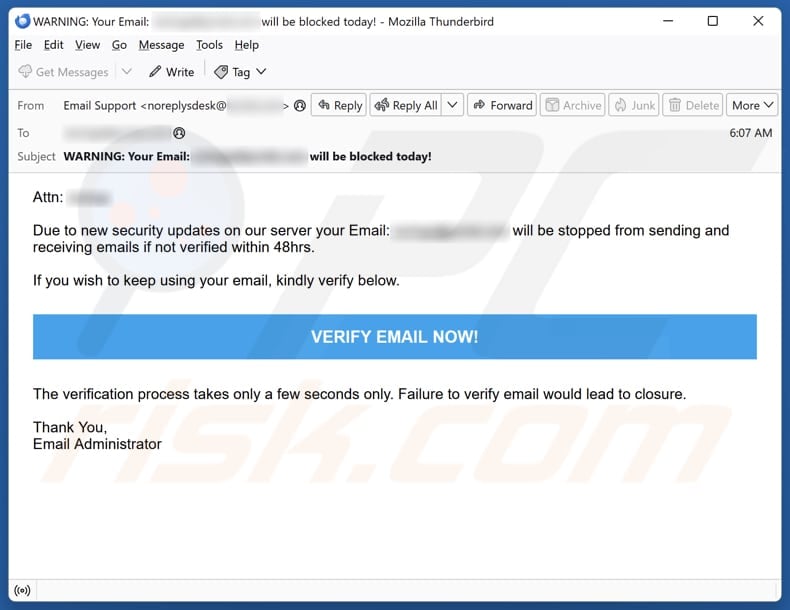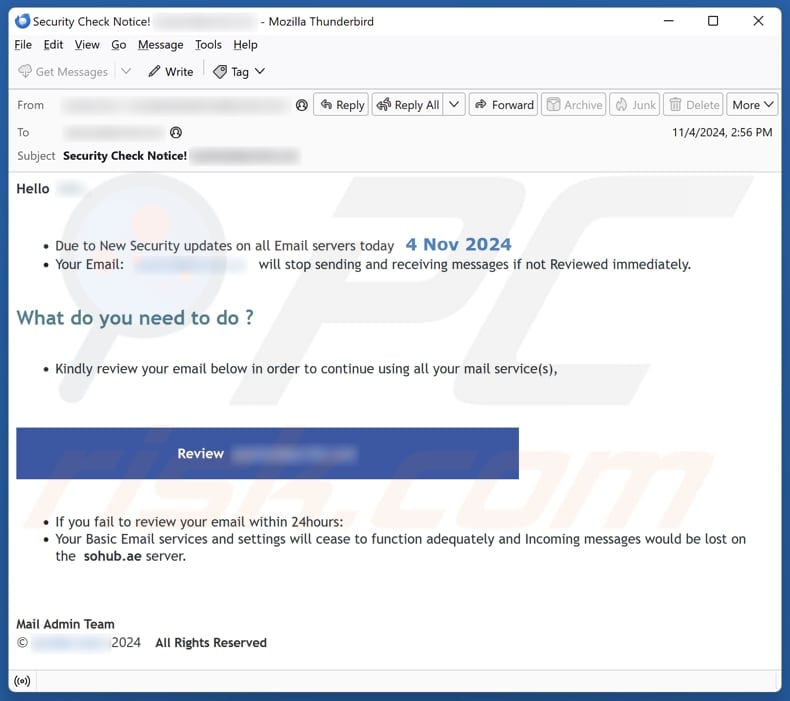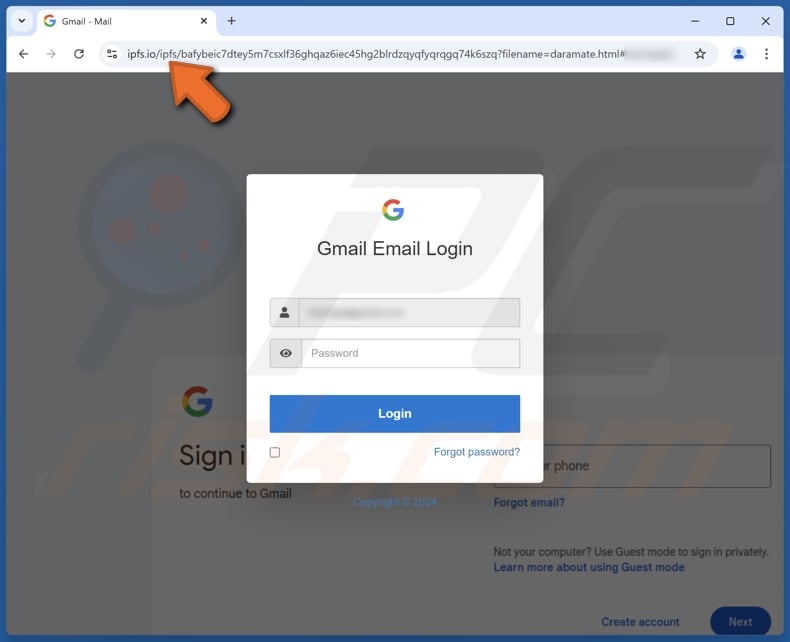How to identify phishing emails like "New Security Updates On Email Servers"
Phishing/ScamAlso Known As: New Security Updates On Email Servers phishing email
Get free scan and check if your device is infected.
Remove it nowTo use full-featured product, you have to purchase a license for Combo Cleaner. Seven days free trial available. Combo Cleaner is owned and operated by RCS LT, the parent company of PCRisk.com.
What kind of scam is "New Security Updates On Email Servers"?
Our team has examined this email and found that it is intended to appear as a notification from an email service provider regarding account security. This is a phishing email crafted by scammers who aim to steal personal information from recipients. It is worth noting that there are two versions of this scam email.

More about the "New Security Updates On Email Servers" scam email
The phishing email claims that due to new security updates, the recipient's email will be disabled unless verified within 48 hours. It urges the recipient to verify their email by clicking a link and warns that failure to do so will result in account closure.
The second variant is pretty similar. The main difference is that it urges recipients to take action within 24 hours. Both emails contain a link/button designed to open a phishing page, mimicking the design of the recipient's email service provider. For instance, if the recipient uses Gmail, the phishing presents a fake Gmail login page.
The purpose of this scam is to lure recipients into disclosing their email account login credentials (email address and password) on a deceptive website. The entered information is sent to scammers. Once scammers have these details, they can access email accounts and look for more sensitive data, send malicious files or links to contacts, etc.
Also, they can try to access other accounts (e.g., social media or banking) and sell the stolen login credentials (and other gathered details) on the dark web. Therefore, it is important to be careful with suspicious emails and never enter personal information on dubious sites.
| Name | New Security Updates On Email Servers Scam |
| Threat Type | Phishing, Scam, Social Engineering, Fraud |
| Fake Claim | The recipient will stop receiving emails if the account is not verified |
| Related Domain | bubbleusa[.]com |
| Detection Names | Combo Cleaner (Malware), CyRadar (Malicious), G-Data (Malware), Lionic (Malware), Sophos (Malware), Full List Of Detections (VirusTotal) |
| Disguise | Letter from an email service provider |
| Symptoms | Unauthorized online purchases, changed online account passwords, identity theft, illegal access of the computer. |
| Distribution methods | Deceptive emails, rogue online pop-up ads, search engine poisoning techniques, misspelled domains. |
| Damage | Loss of sensitive private information, monetary loss, identity theft. |
| Malware Removal (Windows) |
To eliminate possible malware infections, scan your computer with legitimate antivirus software. Our security researchers recommend using Combo Cleaner. Download Combo CleanerTo use full-featured product, you have to purchase a license for Combo Cleaner. 7 days free trial available. Combo Cleaner is owned and operated by RCS LT, the parent company of PCRisk.com. |
Similar scam emails in general
Most phishing emails are designed to trick recipients into disclosing sensitive information, such as passwords, credit card details, ID card information, etc. They often appear as emails from legitimate sources (e.g., service providers) and contain links to deceptive pages. It is important to examine shady emails and avoid clicking suspicious links or opening attachments.
Examples of phishing emails are "Server Has Been Updated - Refresh Your Email", "Avoid Mailbox Interruption", and "American Express - Payment On Hold". Emails of this kind can also be used to trick recipients into infecting computers.
How do spam campaigns infect computers?
Cybercriminals often send malware through emails by including infected attachments or links. If a user opens these attachments (e.g., PDF files, MS Office documents, scripts, or executable files), their computer may become infected. It can occur immediately after opening a file or taking certain actions, like enabling macro commands in compromised Office documents.
Malicious links in phishing emails can lead users to harmful websites that either prompt them to download malware or automatically download it without their knowledge.
How to avoid installation of malware?
Always get software and files from official sites or reputable app stores. It is not safe to use other sources (e.g., unofficial sites, P2P networks, and third-party downloaders). Keep all software and the operating system up to date and use a reputable security tool. Do not trust pop-ups and advertisements on questionable websites.
Exercise caution with emails from unfamiliar senders, particularly if they seem unusual or irrelevant, and never click on links or open attachments in such emails. If you have already opened malicious attachments, we recommend running a scan with Combo Cleaner Antivirus for Windows to automatically eliminate infiltrated malware.
Text presented in the "New Security Updates On Email Servers" email letter:
Attn: -
Due to new security updates on our server your Email: ******** will be stopped from sending and receiving emails if not verified within 48hrs.
If you wish to keep using your email, kindly verify below.
VERIFY EMAIL NOW!
The verification process takes only a few seconds only. Failure to verify email would lead to closure.Thank You,
Email Administrator
Second email variant:

Text in this variant:
Subject: Security Check Notice! ********
******** ,
Due to New Security updates on all Email servers today 4 Nov 2024
Your Email: ******** will stop sending and receiving messages if not Reviewed immediately.What do you need to do ?
Kindly review your email below in order to continue using all your mail service(s),
********
If you fail to review your email within 24hours:
Your Basic Email services and settings will cease to function adequately and Incoming messages would be lost on the sohub.ae server.Mail Admin Team
© ********• 2024All Rights Reserved
Phishing website used to steal information (login credentials):

Instant automatic malware removal:
Manual threat removal might be a lengthy and complicated process that requires advanced IT skills. Combo Cleaner is a professional automatic malware removal tool that is recommended to get rid of malware. Download it by clicking the button below:
DOWNLOAD Combo CleanerBy downloading any software listed on this website you agree to our Privacy Policy and Terms of Use. To use full-featured product, you have to purchase a license for Combo Cleaner. 7 days free trial available. Combo Cleaner is owned and operated by RCS LT, the parent company of PCRisk.com.
Quick menu:
- What is New Security Updates On Email Servers phishing email?
- Types of malicious emails.
- How to spot a malicious email?
- What to do if you fell for an email scam?
Types of malicious emails:
![]() Phishing Emails
Phishing Emails
Most commonly, cybercriminals use deceptive emails to trick Internet users into giving away their sensitive private information, for example, login information for various online services, email accounts, or online banking information.
Such attacks are called phishing. In a phishing attack, cybercriminals usually send an email message with some popular service logo (for example, Microsoft, DHL, Amazon, Netflix), create urgency (wrong shipping address, expired password, etc.), and place a link which they hope their potential victims will click on.
After clicking the link presented in such email message, victims are redirected to a fake website that looks identical or extremely similar to the original one. Victims are then asked to enter their password, credit card details, or some other information that gets stolen by cybercriminals.
![]() Emails with Malicious Attachments
Emails with Malicious Attachments
Another popular attack vector is email spam with malicious attachments that infect users' computers with malware. Malicious attachments usually carry trojans that are capable of stealing passwords, banking information, and other sensitive information.
In such attacks, cybercriminals' main goal is to trick their potential victims into opening an infected email attachment. To achieve this goal, email messages usually talk about recently received invoices, faxes, or voice messages.
If a potential victim falls for the lure and opens the attachment, their computers get infected, and cybercriminals can collect a lot of sensitive information.
While it's a more complicated method to steal personal information (spam filters and antivirus programs usually detect such attempts), if successful, cybercriminals can get a much wider array of data and can collect information for a long period of time.
![]() Sextortion Emails
Sextortion Emails
This is a type of phishing. In this case, users receive an email claiming that a cybercriminal could access the webcam of the potential victim and has a video recording of one's masturbation.
To get rid of the video, victims are asked to pay a ransom (usually using Bitcoin or another cryptocurrency). Nevertheless, all of these claims are false - users who receive such emails should ignore and delete them.
How to spot a malicious email?
While cyber criminals try to make their lure emails look trustworthy, here are some things that you should look for when trying to spot a phishing email:
- Check the sender's ("from") email address: Hover your mouse over the "from" address and check if it's legitimate. For example, if you received an email from Microsoft, be sure to check if the email address is @microsoft.com and not something suspicious like @m1crosoft.com, @microsfot.com, @account-security-noreply.com, etc.
- Check for generic greetings: If the greeting in the email is "Dear user", "Dear @youremail.com", "Dear valued customer", this should raise suspiciousness. Most commonly, companies call you by your name. Lack of this information could signal a phishing attempt.
- Check the links in the email: Hover your mouse over the link presented in the email, if the link that appears seems suspicious, don't click it. For example, if you received an email from Microsoft and the link in the email shows that it will go to firebasestorage.googleapis.com/v0... you shouldn't trust it. It's best not to click any links in the emails but to visit the company website that sent you the email in the first place.
- Don't blindly trust email attachments: Most commonly, legitimate companies will ask you to log in to their website and to view any documents there; if you received an email with an attachment, it's a good idea to scan it with an antivirus application. Infected email attachments are a common attack vector used by cybercriminals.
To minimise the risk of opening phishing and malicious emails we recommend using Combo Cleaner Antivirus for Windows.
Example of a spam email:

What to do if you fell for an email scam?
- If you clicked on a link in a phishing email and entered your password - be sure to change your password as soon as possible. Usually, cybercriminals collect stolen credentials and then sell them to other groups that use them for malicious purposes. If you change your password in a timely manner, there's a chance that criminals won't have enough time to do any damage.
- If you entered your credit card information - contact your bank as soon as possible and explain the situation. There's a good chance that you will need to cancel your compromised credit card and get a new one.
- If you see any signs of identity theft - you should immediately contact the Federal Trade Commission. This institution will collect information about your situation and create a personal recovery plan.
- If you opened a malicious attachment - your computer is probably infected, you should scan it with a reputable antivirus application. For this purpose, we recommend using Combo Cleaner Antivirus for Windows.
- Help other Internet users - report phishing emails to Anti-Phishing Working Group, FBI’s Internet Crime Complaint Center, National Fraud Information Center and U.S. Department of Justice.
Frequently Asked Questions (FAQ)
Why did I receive this email?
Phishing emails are typically sent to a large number of people at once, with the attackers hoping that some recipients will fall for the scam. These emails are often not tailored to specific individuals.
I have provided my personal information when tricked by this email, what should I do?
If you have shared any account credentials, make sure to change the compromised passwords right away. Additionally, enable two-factor authentication on your accounts for extra security and monitor your accounts for any suspicious activity.
I have downloaded and opened a malicious file attached to an email, is my computer infected?
If the file was an executable (.exe), it probably infected your system. If it was a document (.pdf, .doc, etc.), your computer might still be safe, as opening these files does not always trigger malware unless you perform additional actions, like enabling macros.
I have read the email but did not open the attachment, is my computer infected?
Emails themselves cannot infect computers just by being opened. However, clicking on links or opening attachments in fraudulent emails can result in computer infections.
Will Combo Cleaner remove malware infections that were present in email attachment?
Yes, Combo Cleaner can detect and remove most known malware infections. However, advanced malware often hides deeply within the system, so it's important to run a full system scan to ensure complete removal.
Share:

Tomas Meskauskas
Expert security researcher, professional malware analyst
I am passionate about computer security and technology. I have an experience of over 10 years working in various companies related to computer technical issue solving and Internet security. I have been working as an author and editor for pcrisk.com since 2010. Follow me on Twitter and LinkedIn to stay informed about the latest online security threats.
PCrisk security portal is brought by a company RCS LT.
Joined forces of security researchers help educate computer users about the latest online security threats. More information about the company RCS LT.
Our malware removal guides are free. However, if you want to support us you can send us a donation.
DonatePCrisk security portal is brought by a company RCS LT.
Joined forces of security researchers help educate computer users about the latest online security threats. More information about the company RCS LT.
Our malware removal guides are free. However, if you want to support us you can send us a donation.
Donate
▼ Show Discussion